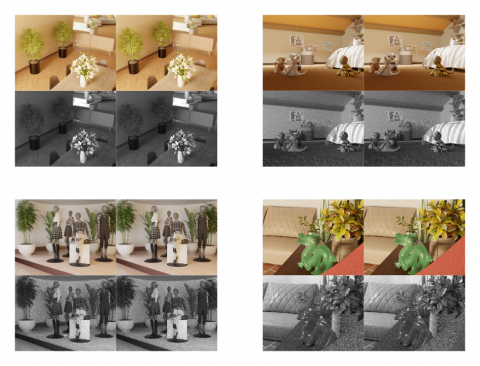Datasets
Open Access
Active-Passive SimStereo
- Citation Author(s):
- Submitted by:
- Laurent Jospin
- Last updated:
- Mon, 02/06/2023 - 19:31
- DOI:
- 10.21227/gf1e-t452
- Data Format:
- License:
 956 Views
956 Views- Categories:
- Keywords:
Abstract
The Active-Passive SimStereo dataset is a simulated dataset created with Blender containing high quality both realistic and abstract looking images. Each image pair is rendered in classic RGB domain, as well as Near-Infrared with an active pattern. It is meant to be used as a dataset to study domain transfert between active and passive stereo vision, as well as providing a high quality active stereo dataset, which are far less common than passive stereo datasets.
Dataset content
The dataset contains 515 image pairs, pre-split into a test set of 103 image pairs and a train set of 412 image pairs.
The images have a standard resolution of 640x480 pixels.
The provided ground truth is precise up to floating point precision.
Raw images and ground truth disparities
The raw images in linear color space, as well as the ground truth disparities, are provided as exr images with 32bits floating point precision.
To read the different layers, any exr library should work fine. We are using the python module provided by the exr-tools project by french-paragon:
https://github.com/french-paragon/exr-tools
You can also inspect the content of the images with the embeded image viewer in blender or any software capable of reading exr images.
- The left and right images are contained in the Left, Respectively Right, Layers.
- The Color, Nir and Disparity Images are contained in the Color, Nir and Disp passes.
- The Color passe is made up of the standard R, G and B channels
- The Nir pass is made up of a single A channel
- The Disp pass is made up of a single D channel
Additional Disparity formats
To make the ground truth disparities easier to use in a variety of situations, we do provide them in npy (python numpy) and pfm (portable float map) formats as well.
Color managed images
We also exported color managed perceptual images (sRGB instead of RGB Linear color space) in standard jpg format if you prefer to use these.
The Images are in the rgbColormanaged and nirColormanaged folder. Each image pair comprises two images with the same name, but the left or right suffix. You can open them with any software or library able to read .jpg images
Dataset paper
If you use our dataset, please cite our paper:
@inproceedings{
jospin2022activepassive,
title={Active-Passive SimStereo - Benchmarking the Cross-Generalization Capabilities of Deep Learning-based Stereo Methods},
author={Laurent Valentin Jospin and Allen Antony and Lian Xu and Hamid Laga and Farid Boussaid and Mohammed Bennamoun},
booktitle={Thirty-sixth Conference on Neural Information Processing Systems Datasets and Benchmarks Track},
year={2022},
url={https://openreview.net/forum?id=ml1NjI-ujzf}
}
[EDIT 04-26-2022] Simulation toolkit
We made the simulation toolkit we used to produce the dataset available so that you can create your own images if you need to. See the simulation.zip file.
[EDIT 06-15-2022] Additional formats for the disparities
We added more image formats for the ground truth disparities to make them easier to use in a variety of scenarios.
[EDIT 08-26-2022] Additional data packs
We released an additional data pack containing 5 sequences of stereo images. More data packs will be released in the future. These data packs are optimized for quantity rather than diversity and as such are based on large sequences of images rather than punctual views of scenes.
Dataset Files
additional_pack1.zip (106.37 GB)
additional_pack2.zip (78.40 GB)
dataset.zip (7.21 GB)
simulation.zip (5.83 MB)







Comments
-
-